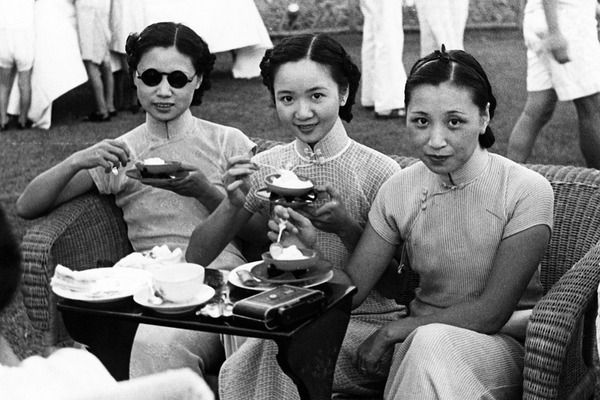
PFH1187079 China: Three fashionable young women at a Shanghai International Settlement tennis match, photograph (1935) Pictures from History. Bridgeman Education. Accessed March 1, 2016. https://www.bridgemaneducation.com/en/asset/1187079/summary?context=%7B%22route%22%3A%22assets_search%22%2C%22routeParameters%22%3A%7B%22_format%22%3A%22html%22%2C%22_locale%22%3A%22en%22%2C%22filter_text%22%3A%22qipao%22%7D%7D
In the photograph China: Three fashionable young women at a Shanghai International Settlement tennis match (1935) by an author who is unknown but provided through Bridgeman images, the audience can see that the qipao because of the strong Western influence it was receiving in the early twentieth century, it was difficult for the qipao itself to represent femininity[1] instead a Western definition was needed as well.
need a thesis statement
As described by the description that accompanies the photograph these three women are attending a tennis match which included the presence of Americans and the British.[2] The environment that these Chinese women are in, is similar to the way the Western influences of the qipao dresses changed how it was designed and how it was worn. These Chinese women are wearing qipaos to this event when in the background of the photo there are people in white shorts and pants, which looks like Western clothing. They all have qipao’s made of cotton and are decorated with checkered, striped and flowered pattern designed much more differently during this time.[3] Their hairstyles and the sunglasses one of them is wearing are from Western influence. In this environment these Chinese women look Western, but they stand out because they are wearing qipaos.
Apart from the dresses and hairstyle, the photographer took a picture of the women seated and enjoying their liesure activity, without capturing the slit of a qipao dress. Again during this time women were wearing qipaos that weren’t as conservative as they were before. They shaped the body and had slits where was best seen on women of calendar posters and represented femininity.[4] By not choosing to picture these women with the slit of their dress was another way of ignoring the style that was providing Chinese women a bit more freedom physically after always wearing conservative clothing and Chinese femininity. The audience is seeing femininity by the way they are eating their food. Their index and middle finger are being used to carefully hold the plates, which is displaying their daintiness and their class.
From this photograph I see a different view of the Chinese woman wearing the qipao than that was being made in calendar posters also during this time. The Chinese women were wearing outfits with a lot of Western influence. These Chinese women were photographed so people could see their femininity through a Western perspective not Chinese regardless of the fact that they were wearing qipaos.
sounds that western perspective and influence are the potential thesis. If so, introduce it at the beginning of the post and allow it to guide your analysis and reader’s perception
[1] Ellen Johnston Laing. “Visual Evidence for the Evolution of ‘Politically Correct’ dress for Women in Early Twentieth Century Shangai,” Nan Nu-Men, Women and Gender in Early and Imperial China 5, no.1 Edited by Leiden Brill (April 2003): 108, 114
[2] Bridgeman Education. “China: Three fashionable young women at a Shanghai International Settlement tennis match.” (1935) Pictures from History. Bridgeman Education. Accessed March 1, 2016. https://www.bridgemaneducation.com/en/asset/1187079/summary?context=%7B%22route%22%3A%22assets_search%22%2C%22routeParameters%22%3A%7B%22_format%22%3A%22html%22%2C%22_locale%22%3A%22en%22%2C%22filter_text%22%3A%22qipao%22%7D%7D
[3] Ellen Johnston Laing. “Visual Evidence for the Evolution of ‘Politically Correct’ dress for Women in Early Twentieth Century Shangai,” Nan Nu-Men, Women and Gender in Early and Imperial China 5, no.1 Edited by Leiden Brill (April 2003): 104
[4] Ellen Johnston Laing. “Visual Evidence for the Evolution of ‘Politically Correct’ dress for Women in Early Twentieth Century Shangai,” Nan Nu-Men, Women and Gender in Early and Imperial China 5, no.1 Edited by Leiden Brill (April 2003): 108
